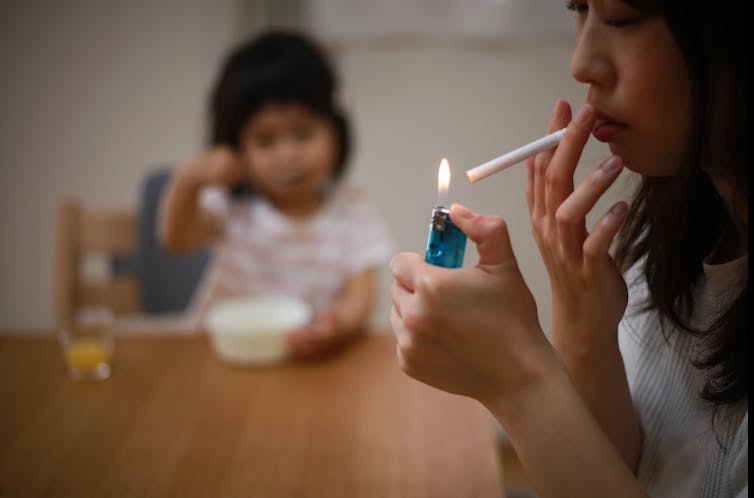
Genny Carrillo, Texas A&M University and Taehyun Roh, Texas A&M University
Secondhand smoke may be an important but overlooked source of chronic lead exposure in kids and adolescents. That is the key finding of our recent study, published in the journal BMC Public Health.
We analyzed national data on blood lead levels and secondhand smoke exposure in 2,815 U.S. children and teenagers ages 6 to 19 from 2015 to 2018. We looked at levels of lead and a nicotine metabolite – a substance known as cotinine produced in the body’s chemical process that forms when tobacco smoke is inhaled. Levels of cotinine indicate exposure to tobacco smoke.
We found that the average blood lead levels in the intermediate and high tobacco smoke exposure groups were 18% and 29% higher, respectively, than those in the group with the lowest tobacco smoke exposure. The lowest lead exposure group was comparable to the U.S. average. A greater number of boys had detectable lead levels in their blood, as did a greater number of Black children and adolescents, compared with the other ethnic groups we studied.
Elevated blood levels were more common in children ages 6 to 10 than in older participants. Notably, children from low-income households showed 27% higher blood lead levels compared with those from high-income households.
Why it matters
Lead, unlike many other toxins, does not get diluted when exposure decreases. Nor does the body excrete it naturally. Instead, it accumulates in the bones and leaches into blood. The only way to remove it is through an oral medical treatment.
Exposure to lead can cause numerous and severe neurological problems, including nerve damage, cognitive problems, loss of IQ points and possibly even conditions such as Alzheimer’s disease and schizophrenia.
Lead exposure is more harmful to younger children than older children and adults because their bodies are still developing and they are growing so rapidly.
Children at high-exposure risk often come from low-income households in older homes built before 1978, when lead paint was still used. Young children’s frequent hand-to-mouth activity provides a pathway for lead exposure at home. Lead-containing water pipes in these older, low-income housing areas also contribute to the issue.
Children and others can also be exposed to lead through a variety of everyday household items, including some ceramic cookware and dishes, some vinyl lunchboxes – especially those manufactured outside the United States – many common spices and some toys, hair-coloring products and cosmetics. Lead exposure has even been traced to some candies from Mexico.
Over the past four decades, U.S. regulators have banned lead-based paint for residential use and leaded gasoline. This has led to a significant decrease in lead exposure from major traditional sources.
Despite continued efforts, lead exposure continues to pose a risk. Our findings help create awareness of the link between secondhand tobacco smoke and lead exposure, especially for young people. Approximately 35% of U.S. children, or over 23 million, were exposed to secondhand smoke between 2013 and 2016, according to the Centers for Disease Control and Prevention.
What’s next
We are working within our local areas to educate parents and school administrators about the dangers of lead poisoning, including exposure from secondhand smoke. Our efforts include encouraging individuals and communities to test their drinking water for lead and to take actions to reduce children’s lead exposure from drinking water.
We plan to conduct further studies to quantify the contribution of various sources to lead exposure. We believe that this research will enhance our understanding of children’s exposure and contribute to the improvement of environmental health disparities.
The Research Brief is a short take on interesting academic work.![]()
Genny Carrillo, Associate Professor of Environmental and Occupational Health, Texas A&M University and Taehyun Roh, Assistant Professor of Epidemiology, Texas A&M University
This article is republished from The Conversation under a Creative Commons license. Read the original article.